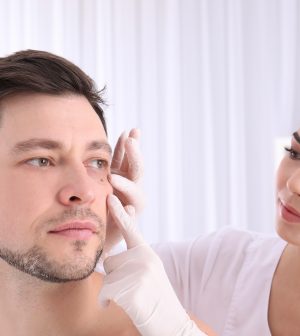- Strengthening Your Relationship: Practical Strategies
- Skip Storing This Everyday Product in the Fridge Door
- Green Tea + B3 Pairing May Boost Brain Health
- Navigating Your Midlife Crisis: Embracing New Possibilities
- City Raccoons Showing Signs of Domestication
- Mapping the Exposome: Science Broadens Focus to Environmental Disease Triggers
- One Week Less on Social Media Linked to Better Mental Health
- Your Brain Changes in Stages as You Age, Study Finds
- Some Suicide Victims Show No Typical Warning Signs, Study Finds
- ByHeart Formula Faces Lawsuits After Babies Sickened With Botulism
Skin Biopsy? Here Are Tips on Wound Care

A skin biopsy is often used to diagnose skin cancer and other skin conditions.
It involves the removal of a small amount of skin, which is examined under a microscope. Afterwards, you’ll need to look after the biopsy location to make sure it heals properly.
“Your dermatologist will treat the small wound from the skin biopsy during your visit,” said dermatologist Dr. Rajiv Nijhawan, an associate professor at UT Southwestern Medical Center in Dallas.
“Continuing to care for your wound once you get home is important because it will help it heal, reduce scarring and decrease chances of infection,” he said in an American Academy of Dermatology news release.
Wash your hands before touching your wound. To care for your wound, gently wash the biopsy area with mild soap and water. Rinse thoroughly and gently pat dry with a clean wash cloth.
To keep the wound moist and help it heal faster, apply petroleum jelly from a squeeze tube to the wound. Then cover the wound with an adhesive bandage or sterile gauze and paper tape. Do this daily for as long as your dermatologist recommends.
Do not use topical antibiotics unless advised by your dermatologist because they can cause allergic reactions.
Applying petroleum jelly can also help relieve itching as the wound heals. Itching can also be a sign of an allergic reaction or skin irritation. Cover the wound with a nonstick pad and paper tape instead of an adhesive bandage.
If your wound starts bleeding, apply firm and steady pressure with a sterile gauze pad for 20 minutes. Call your dermatologist’s office if your wound is still bleeding after 20 minutes.
If you have pain at the biopsy site, take acetaminophen or place an ice pack over the bandage to relieve swelling.
Reduce scarring by protecting the biopsy site from the sun. Cover it with sun-protective clothing, apply a broad-spectrum, water-resistant sunscreen with an SPF of 30 or higher, and stay in the shade when possible.
“If you have any signs of infection such as worsening pain, increased swelling, warmth or fever, contact your dermatologist,” Nijhawan said.
More information
For more on skin biopsy, see the U.S. National Library of Medicine.
SOURCE: American Academy of Dermatology, news release, May 31, 2022
Source: HealthDay
Copyright © 2025 HealthDay. All rights reserved.










